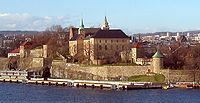- List of Norwegian fortresses
-
For castles in Norway, see List of castles in Norway.
Norwegian fortresses or fortifications have been constructed from some of the earliest recorded periods, down through the 20th century. The geography and topography of glacially carved, mountainous Norway constrain both the sea and the land routes which an aggresser must follow. Natural strong-points, such as rock outcroppings at Halden, Tønsberg and Trondheim make excellent bases for fortification (i.e., natural fortresses).
Fortifications evolved to accommodate the offensive threat which they guard against. Early castles provided a strong defense against the attack of the day, and were normally taken by duplicity or siege. In the age of black powder, cannon allowed breaching of the fortress walls and subsequent taking by storm. As a result fortresses changed form, now incorporating design features like the bastion, ravelin, and glacis to allow cannon within the fortress to be effective while protecting the walls and defenders from external attack. This evolution of technology continued into the 20th century as weaponry continued to evolve.
Contents
Historical context for Norwegian fortresses
Civil Wars
Baltic Power Wars
Most Norwegian fortresses were constructed in the period of intense competition among the Baltic powers (Denmark-Norway, Sweden, Russia, Poland and the German states) for northern supremacy. The 16th, 17th and beginning of the 18th Century was a period of virtually continuous war or preparation for war:
- 1563 to 1570 - Nordic Seven Years' War
- 1611 to 1613 - Kalmar War
- 1618 to 1648 - Thirty Years' War (See also Hannibal War)
- 1655 to 1658 – Northern War
- 1673 to 1675 – Fortification Upgrades
- 1675 to 1679 – Gyldenløve War
- 1700 to 1721 – Great Northern War
In 1600 Denmark controlled virtually all land bordering on the Skagerrak, Kattegat, Store Bælt and the restricted Sound (Øresund). The current Swedish provinces of Skåne and Halland were Danish and the province of Båhuslen was then Norwegian (as they had been for all recorded history). All powers interested in Baltic trade, or otherwise forced to pass through waters controlled by Denmark, had a strong interest in breaking Denmark’s control and lifting the Sound Dues that Denmark levied for passage through the Øresund. Hence the naval trading powers, particularly Holland and England, contributed to the Northern unrest of the period.
And the larger political balance in Europe can not be forgotten. As one example, the danger of French domination under Louis XIV resulted in a 1668 triple alliance of England, Holland and Sweden. This alliance worked to Sweden’s favor when treaties were negotiated.
Union with Sweden
Twentieth century
Norwegian fortresses
The Castle Period (1600 and earlier)
- Akershus Fortress in Oslo
- Audunborg in Jølster
- Bergenhus Fortress in Bergen
- Båhus Fortress
- Hamarhus Castle in Hamar
- Isegran in Fredrikstad
- Steinvikholm Castle in Stjørdal
- Sverresborg Castle in Trondheim
- Sverresborg Castle in Bergen
- Tønsberg Fortress
- Vardøhus Fortress
The Age of Black Powder (1600 - 1900)
- Fredriksberg fortress
- Fredrikstad Fortress
- Fredriksten Fortress
- Fredriksværn
- Kongsvinger Fortress
- Basmo Fortress
- Blaker Fortress
- Christiansfjell Fortress
- Munkholmen Fortress (Trondheim)
- Staverns Fortress
- Christiansholm Fortress
- Christiansø Fortress
- Kristiansten Fortress (Trondheim)
Modern fortresses
References
- Norges festninger by Guthorm Kavli; Universitetsforlaget; 1987; ISBN 82-00-18430-7
- The Struggle for Supremacy in the Baltic: 1600-1725 by Jill Lisk; Funk & Wagnalls, New York, 1967
- The Northern Wars, 1558-1721 by Robert I. Frost; Longman, Harlow, England; 2000 ISBN 0-582-06429-5
External links
Categories:- Forts in Norway
- Lists of buildings and structures
- Norway-related lists
Wikimedia Foundation. 2010.

